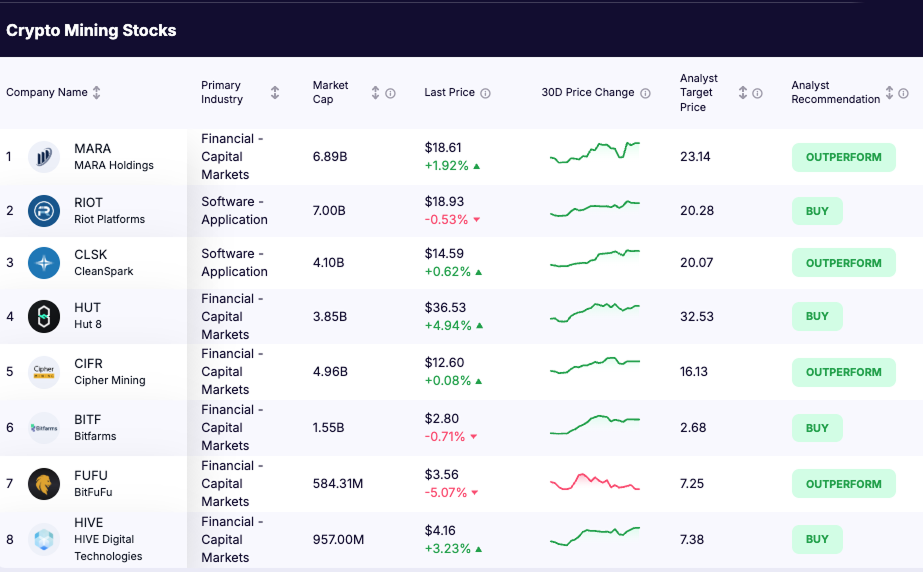One of the most common questions in 2025 is how to invest in crypto without buying tokens directly. The answer for many investors has been cryptocurrency stocks, publicly traded companies that derive significant revenue or value from digital assets.
In 2025 the sector has regained powerful momentum. Bitcoin trades above $118,000 and Ethereum holds steadily over $4,300, reflecting not just retail enthusiasm but also deeper institutional involvement.
Spot Bitcoin and Ethereum ETFs have attracted billions of dollars from investors, making it easier for institutions to gain exposure through regulated products. Pension funds and sovereign wealth funds are starting to add digital assets to their portfolios, showing that crypto is no longer just a retail-driven market.
At the same time, staking has become a widely used method for earning yield on Ethereum, and tokenized assets are beginning to play a role in traditional finance.
All of these trends together have created the strongest backdrop for cryptocurrency stocks since the last cycle, with miners, custodians, and holding companies benefiting the most.
What makes the topic complex is that cryptocurrency stocks are not all the same. Some mine tokens, others hold them on their balance sheets, while others provide the infrastructure that allows markets to function. For investors, understanding these categories is key to choosing the right exposure.
This article reviews the three main types of cryptocurrency stocks in 2025:
- Crypto miners
- Crypto holders
- Custodians and exchanges
1. Crypto Mining Stocks
Mining companies provide the computing power that secures networks such as Bitcoin and, indirectly, Ethereum. They are capital intensive and highly sensitive to energy costs, network difficulty, and crypto prices. In 2025, many miners have also started to diversify into high performance computing for AI to stabilize revenues.
Notable names in 2025
- Marat Holdings Inc. (MARA) – One of the largest Bitcoin miners in the world. As of Aug 2025, it disclosed holdings of around 52,477 BTC, which makes it both a leading miner and one of the largest public corporate holders of Bitcoin.
- Riot Platforms Inc. (RIOT) – A U.S.-based miner with large-scale operations in Texas. Its long-term, low-cost power agreements have given it an edge in operating efficiency and cost stability. Riot Platforms are sitting on 19,309 Bitcoins as of Aug. 31, 2025.
- CleanSpark Inc. (CLSK) – A fast-growing U.S. miner with a focus on sustainable energy use. CleanSpark held approximately 12,827 BTC in 2025 and continues to expand its footprint across North America.
- Hut 8 Mining Corp. (HUT) – A Canadian miner that merged with U.S. Bitcoin Corp in 2023, creating one of the largest publicly traded Bitcoin miners in North America. Hut 8 emphasizes both mining scale and high-performance computing services. Hut 8 Mining owns 10278 BTC as of Aug. 25, 2025.
- Cipher Mining Inc. (CIFR) – A U.S. miner focused on building out energy-efficient mining facilities. Its Texas operations benefit from flexible grid contracts that reduce costs during peak demand. Cipher Mining owns 1,414 bitcoins as of Aug. 31, 2025
- Bitfarms Ltd. (BITF) – Headquartered in Canada with operations in North and South America. Bitfarms is notable for using primarily hydroelectric power, giving it a strong ESG profile. As of mid-August 2025, Bitfarms (BITF) held approximately 1,402 Bitcoins, which was a significant increase from earlier periods and part of their treasury management strategy.
- BitFuFu (FUFU) – A hybrid miner that combines Bitcoin mining with treasury accumulation. By mid-2025, it disclosed holdings of over 1,899 BTC, giving it dual exposure as both a producer and holder.
- Hive Digital (HIVE) – Originally focused on Ethereum and Bitcoin mining, Hive has transitioned into a diversified model that combines Bitcoin production, Ethereum staking, and AI-driven data center services.

Ethereum validation stocks
While Ethereum moved away from mining after its 2022 transition to proof of stake, companies now participate through staking.
- BTCS (BTCS) operates validator nodes and as of 2025 holds around 70,000 ETH.
- BitMine Immersion Technologies shifted focus and now holds over 2,650,000 ETH, making it the largest publicly listed Ethereum holder.
Risks
Mining stocks face intense volatility. Profitability can swing sharply when network difficulty rises, energy costs fluctuate, or token prices drop suddenly. Their equity valuations often amplify the moves of the underlying assets.
2. Crypto Holding Stocks
These companies are best thought of as publicly listed treasuries that own Bitcoin, Ethereum or both. Their stock performance is strongly correlated with crypto markets, often trading at premiums or discounts to the net asset value of their holdings.
Key names in 2025
- MicroStrategy (MSTR) – The largest and most influential Bitcoin treasury stock. As of October 2025, the company holds around 640,031 BTC at an average cost near $73,983 per coin. MSTR’s stock is widely treated as a leveraged proxy for Bitcoin itself.
- Tesla (TSLA) – Among the few mega-cap companies with direct Bitcoin exposure. Tesla continues to hold about 11,509 BTC, a relatively small portion of its balance sheet but still one of the largest corporate crypto positions outside of the financial sector.
- Block (SQ) – Jack Dorsey’s payments and fintech firm has consistently maintained around 8,692 BTC as part of its balance sheet strategy. Its long-term positioning reflects its deep integration of Bitcoin into products such as Cash App.
- Metaplanet (3356.T, Tokyo) – A Japanese investment company that has adopted Bitcoin as a core treasury asset. By 2025, it holds nearly 30,823 BTC, positioning itself as one of the few Asia-listed Bitcoin proxy stocks.
- SharpLink Gaming (SBET) – Though outside the usual tech or finance space, SharpLink has become one of the largest Ethereum holders, with over 838,728 ETH in its treasury. Its stock performance is now tightly tied to ETH price movements.
- KR1 plc (KR1.L, London) – A UK-listed investment firm with a long history in digital assets. Its treasury includes Ethereum and other Web3 assets, giving European investors equity-based exposure to crypto without direct token purchases.
These stocks attract investors who want direct crypto exposure without wallets or exchanges, though they come with their own risks, such as dilution when firms issue new shares to buy more crypto.
3. Custodians, Exchanges, and Infrastructure
The third category includes the companies that provide the trading, settlement, and custody infrastructure for crypto markets. Their revenues depend less on the price of Bitcoin or Ethereum directly and more on transaction volumes, adoption, and institutional flows.
Major names in 2025
- Coinbase (COIN): The leading U.S. exchange, benefiting from its role as custodian for Bitcoin and Ethereum ETFs.
- Bullish (BULL): Listed in 2024, it has built a reputation as an institutional-friendly exchange with strong compliance standards. It also discloses a treasury of several tens of thousands of BTC.
- Circle (CRCL): The issuer of USDC stablecoin. After going public in 2025, it is now considered a core infrastructure stock as stablecoins remain critical to global liquidity.
- Robinhood (HOOD): A retail trading platform that derives a material share of transaction revenue from crypto.
- Galaxy Digital (GLXY.TO): A financial services firm specializing in asset management, custody, and investment banking for the digital asset sector.
Why this group matters
Custodians and exchanges represent the “picks and shovels” of crypto. They may not own massive amounts of tokens, but they benefit from the structural growth of trading volumes, institutional custody needs, and stablecoin adoption.
Comparing the Three Categories
Category | Main Exposure | Example Stocks | Strengths | Weaknesses |
Miners | Network rewards, BTC production, some ETH staking | MARA, RIOT, HIVE, BitFuFu | High leverage to BTC price | Very volatile, energy sensitive |
Holders | Treasury value of BTC/ETH | MSTR, BitMine, CleanSpark | Pure price exposure | Dependent on accounting, dilution |
Custodians & Exchanges | Trading volume, custody, stablecoin flows | COIN, BULL, CRCL, HOOD | Infrastructure-driven, scalable | Regulatory and margin pressure |
Top 10 Public Bitcoin Holding Companies (Oct 2025)
No. | Company | Ticker(s) | BTC Held | Market Value ($) |
1 | MicroStrategy | MSTR | 506,137 | $59.7B |
2 | Marathon Digital | MARA | 26,842 | $3.17B |
3 | Galaxy Digital | GLXY.TO | 15,449 | $1.82B |
4 | Tesla | TSLA | 11,509 | $1.36B |
5 | Coinbase Global | COIN | 9,183 | $1.08B |
6 | Hut 8 Mining | HUT / HUT.TO | 9,102 | $1.07B |
7 | Riot Platforms | RIOT | 8,490 | $1.00B |
8 | Block (Square) | SQ | 8,038 | $0.95B |
9 | CleanSpark | CLSK | 6,154 | $0.73B |
10 | Metaplanet | 3356.T (Tokyo) | 2,888 | $0.34B |
Top 10 Public Ethereum Holding Companies (Oct 2025)
No. | Company | Ticker(s) | ETH Held | Market Value ($) |
1 | SharpLink Gaming | SBET | 360,807 | $1.58B |
2 | BitMine Immersion | BITM (OTC) | 300,657 | $1.32B |
3 | Coinbase | COIN | 137,300 | $0.60B |
4 | Bit Digital | BTBT | 120,306 | $0.53B |
5 | BTCS Inc. | BTCS | 55,788 | $0.24B |
6 | GameSquare | GAME / GAME.V | 10,170 | $44.5M |
7 | Intchains | ICG | 7,023 | $30.7M |
8 | KR1 plc | KR1.L (London) | 5,500 | $24.1M |
9 | Exodus | EXOD (unlisted, Reg A+) | 2,550 | $11.2M |
10 | BTC Digital Ltd | BTCT | 2,100 | $9.2M |
Key Takeaways for Investors
- Cryptocurrency stocks are diverse – Miners, holders, and exchanges/custodians each offer distinct exposures. Miners are high-beta bets on Bitcoin production costs and network rewards, holders trade as proxies for BTC or ETH prices, and exchanges earn from volumes and custody demand.
- Ethereum has secured its place alongside Bitcoin – With public companies like SharpLink Gaming (SBET) and BitMine Immersion (BITM) disclosing hundreds of thousands of ETH on balance sheets, equity investors now have liquid proxies for both leading digital assets.
- Institutional adoption is accelerating – Spot Bitcoin and Ethereum ETFs, pension fund allocations, and sovereign wealth fund entries show that crypto ownership is no longer confined to retail investors. This deepens liquidity and strengthens the case for listed proxies.
- Regulation is the main uncertainty – Rules around custody, stablecoins, accounting, and capital treatment will directly shape the profitability and resilience of custodians, exchanges, and treasury holders.
- Diversification within the sector is key – Each category reacts differently to market cycles. Combining exposure to miners, holders, and infrastructure providers may help balance the volatility inherent in crypto-linked equities.




